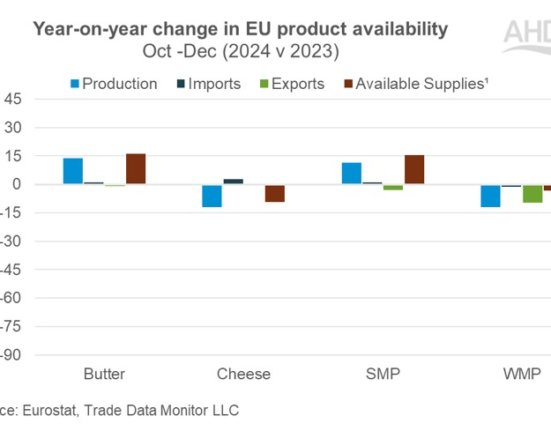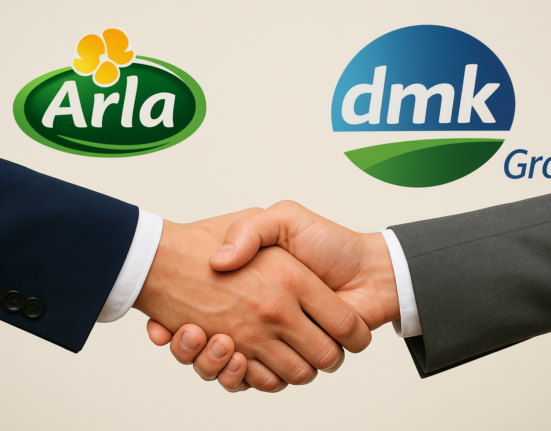Fonterra, New Zealand’s largest dairy co-operative, has reported robust interim financial results, underscoring its strategic pivot toward business-to-business (B2B) operations while steadily advancing its plan to divest its Consumer division.
For the six-month period, Fonterra posted a net profit of NZ$729 million, reflecting an 8% year-on-year increase, with operating profit rising 16% to NZ$1.07 billion. Earnings per share climbed 10% to 44 cents, and the interim dividend was declared at 22 cents per share, fully imputed. The full-year FY25 earnings guidance remains unchanged at 55–75 cents per share.
A Look at the Numbers
Despite the positive topline performance, Return on Capital (ROC) dipped from 13.4% to 10.2%, largely reflecting heavier investment and margin pressure in certain segments. The forecast farmgate milk price range has been narrowed to NZ$9.70–$10.30 per kgMS, with a midpoint of NZ$10.00, signaling cautious optimism amid changing weather patterns. Milk collections are expected to rise 2.7% to 1.51 million kgMS, driven by favorable pasture growth earlier in the season, although recent dry conditions may temper future gains.
B2B Units Power Growth
The standout performer this period was Fonterra’s Ingredients division, delivering an operating profit of NZ$696 million, up NZ$229 million year-on-year—even as volumes fell by 3.9%. This underscores the co-op’s ability to extract more value from high-margin products such as specialty powders, milk proteins, and base ingredients for multinational customers.
The Foodservice division, however, experienced margin compression, with operating profit down from NZ$342 million to NZ$230 million, due to higher input costs and continued volatility in global food markets.
Surprisingly, the Consumer business—now marked for divestment—showed resilience, with volumes up 8.5% and margin improvement despite higher milk input prices. Its operating profit held steady at NZ$173 million.
Strategic Focus: From Supermarket Shelves to Industrial Supply Chains
This performance builds on years of strategic recalibration. Fonterra, once heavily reliant on branded consumer products across Australasia and Asia, has been gradually shifting its focus back to its core strength: serving global industrial and foodservice customers with high-value ingredients and tailored dairy solutions.
The decision to divest its Consumer and associated businesses marks a defining move in that transformation. CEO Miles Hurrell confirmed that the dual-track divestment process—evaluating both an IPO and a trade sale—is progressing as planned, and that the co-op is committed to delivering optimal value to its farmer shareholders.
“The co-op is in great shape, with milk collections, the forecast Farmgate Milk Price, and earnings all up on this time last year,” said Hurrell. “We’re focused on maintaining this momentum while advancing our strategy, including the divestment of our Consumer business.”
Historical Perspective: From Dairy Giant to Ingredient Powerhouse
Historically, Fonterra emerged from the 2001 merger of New Zealand’s two largest dairy cooperatives and the Dairy Board, creating a global dairy powerhouse with a mandate to serve farmers and push Kiwi dairy worldwide. For years, it aggressively expanded its Consumer presence in Asia and the Pacific, investing in brands like Anchor, Anlene, and Anmum.
However, growing competition, capital constraints, and fluctuating returns from consumer markets led to a strategic rethink around 2018–2019. Since then, the co-op has divested non-core businesses, refocused on value-added ingredients, and prioritized sustainability and innovation in dairy processing.
Next Chapter: Manufacturing Expansion and Sustainability Ties
Fonterra is now investing in new manufacturing capacity, with projects underway at Studholme to enhance high-value protein output and at Edendale to build a UHT cream plant, aligning with global demand for shelf-stable dairy.
Sustainability continues to be a priority, with farmer-facing incentives such as the co-op’s own sustainability-linked milk pricing structure. Recent partnerships with Nestlé and Mars further strengthen its ESG credentials, opening up funding and supply chain collaboration.
Investor Outlook: A Competitive Bidding Arena?
The strength of these interim results may bolster Fonterra’s position as it heads into negotiations with prospective investors or trade buyers for its Consumer unit. With the co-op keeping its options open and refusing to rush the sale, a competitive bidding scenario may emerge, giving Fonterra more leverage to maximize returns for its 9,000+ farmer owners.







